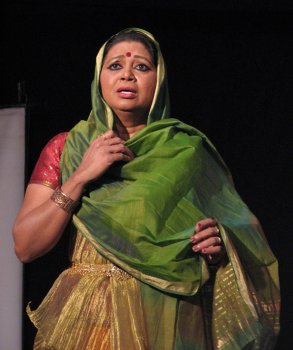
|
 |

|
 |
Rajashree Shirke: Dance is a multi-layered and dependent art - Lalitha Venkat December 17, 2008  An exponent of Kathak and Bharatanatyam, Rajashree Shirke has through a deep and prolonged practical study, managed to capture and retain in her performance the technique and nuances of both these styles. She has performed extensively in India and aboard. Rajashree is the Principal of the Lasya Centre of Dance Education and Research, which conducts a Diploma in Kathak and Bharatanatyam. She is a recognized theoretician and an acclaimed academician. To add to her list of achievements, Rajashree Shirke is also a gifted creative writer, a highly acclaimed and awarded actor. The Founder Director of Lasya, she continues to dedicate her life and work to the spread and preservation of the Kathakar tradition of Kathak. She is also actively involved in imparting dance training to underprivileged children. 'Madan Samhara': A study of Avadhi language of the 'Ramcharitra Manas' of Tulsidas, is one of her research works. Lasya conducts an annual festival called Yatra. How did you adapt Mahesh Elkunchwar's old play 'Pratibimb' to present a classical dance theatre presentation 'Haravele Pratibimb' and add the touches of humour in dance? 'Haravele Pratibimb' is not a pure dance adaptation but falls in the genre of theatre-dance (Ranga-nritya), which is a symbiotic presentation of spoken dialogues and dance. In this are some elements of classical dance that have been used in bits and parts. The playwright has written scenes which are a play of imagination and fantasy, and those especially have been interpreted through dance. Some scenes of black humour, at times subtle dry humour, have been adapted completely in dance, without losing the context and the theme of the original text; for example, the landlady singing a javali to entice the paying guest, the use of meaningless chollus to symbolize nonsensical talk, the shaving scene, a fight between a lion and a deer, the momentary transformation of the paying guest into a woman and the landlady into a man through a traditional hori, the dance of the lady with a lost reflection...etc. How have Ramayana themes influenced your dance repertoire? Apart from my choreographic work 'Ravana-Mandodari Samvaad,' I have always presented episodes from Ramayana in traditional Kathak performances, in my Gat-bhav sections - Sita Harana, Jatayu Mokhsa, Sita Swayamwara, Shurpanakha. Recently I have choreographed a solo Bharatanatyam piece Shravan Kathaa. I feel epics like Ramayana are a part of us as Indians; we grow with them, live with them and leave the world beseeching Rama to give us moksha. How do you perceive 'Ravana Mandodari Samvaad' in Kathak? For quite some time, I felt that the Bhava-paksha of Kathak, in the present-day performances, was not as widely explored as the Nritta-paksha. That's when I was drawn towards the Kathaakaar paramparaa (the art of story telling) of Kathak. Kathak was known as kathkaa kare so Kathak. The genesis of the style of Kathak in fact is traced back to this format of presentation which was prevalent in the temples. Ravana-Mandodari is a recreation of this concept of Kathaakaar padhati where entertainment and education-upedasha went hand in hand. This recreation, of course, with my sensibilities of the contemporary woman, is about the conflict between dharma and adharma as seen from Mandodari's point of view. In the various conferences that you have attended, what strikes you most? Dance is a multi-layered and dependent art. Hence any conference which is well designed, definitely, in one way or the other helps to gain a better understanding of your own faculty. Meeting other scholars, sharing, does promote your growth and interest in dance. What importance do you think NKC plays in the field of performing arts? Firstly, as an arts administrator, I am aware of the difficulties in beginning any new venture, and to consistently keep it alive is all the more difficult. Hence the fact that NKC has been consistently held for these many years, and in addition to this, the finest dancers/choreographers/teachers of the country have been invited to share their views over the years, is truly commendable - a great service to art. Every work of art has the personal fragrance and flavour of the artist who creates it, be it the art of performance or the art of teaching or choreography or arts administration. A conference like this provides the artistes a platform to place forth their individual viewpoint - their perception of the art of dance, and for the connoisseurs, a view into that process of art creation. NKC is a genuine and serious platform for artistes to share/discuss/analyze the art of dance, essential for the growth of the artiste and the art. Your comments on the Chennai December season. The amount of energy that classical dance and music receives is simply fantastic. Look at the scenario from this perspective. Young talented dancers, seasoned dancers, old themes, new themes kept alive, research done for new presentations, the amount of music created, search for new motifs in dance, or placing of old motifs in contemporary age and so on... I am truly amazed. Contact: e-mail: rajashreeshirke.2008@rediffmail.com |